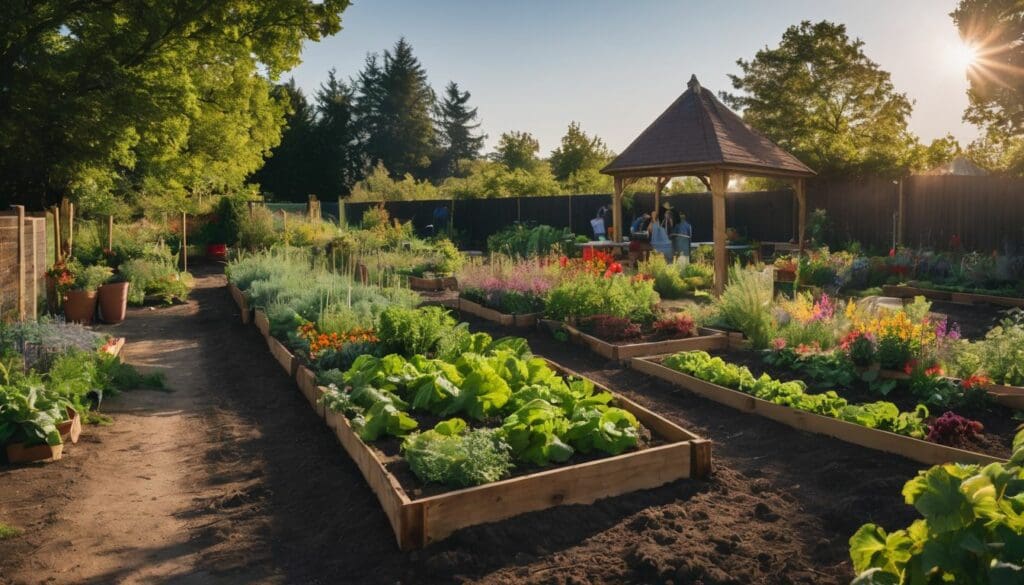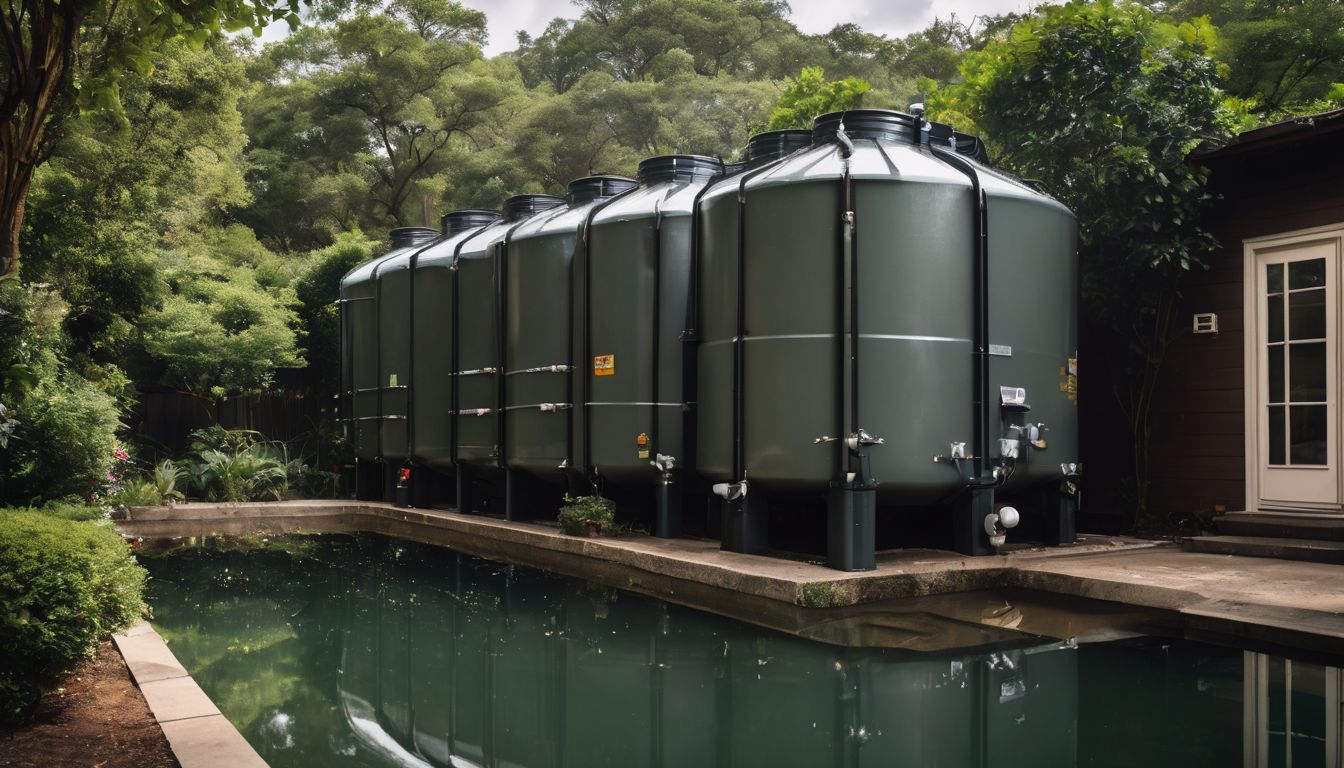Finding space to grow fresh produce can be a challenge in urban areas. Community gardens offer a shared green oasis in towns and cities. This article guides you through the practical steps to start your own patch of paradise, from rallying neighbours to planting seeds.
Ready for the first spade of soil?.
Key Takeaways
- Start by forming a dedicated group of garden enthusiasts and engage your community to build interest and support.
- Select a location that is accessible, receives plenty of sunlight, has easy access to water, and where you can secure usage rights from the landowner.
- Develop a clear plan for your garden regarding layout, rules, maintenance schedules, and budgeting to ensure smooth operation and involvement.
- Obtain necessary resources such as materials and funding through local sponsorships, grants or community fundraisers.
- Celebrate successes together to foster community spirit while continuously addressing any issues that arise as the garden develops.
Why Start a Community Garden?
Community gardens serve as vibrant hubs for urban gardening, bringing together individuals who share a passion for growing vegetables and fostering community development. These green patches can transform empty lots into productive lands where neighbours collaborate, learn about sustainable gardening, and contribute to local food security.
Starting such a garden encourages people to engage in organic gardening practices that nourish both the earth and the community.
Engaging in neighbourhood gardening offers educational opportunities, particularly for children and those new to horticulture. Participants gain hands-on experience in plant cultivation while witnessing the lifecycle of their food from seedling to harvest.
Additionally, these spaces often become social centres that strengthen bonds among residents and enhance the beauty of urban environments, making them more liveable and enjoyable for everyone involved.
Steps to Establish a Community Garden
To establish a community garden, you need to involve neighbours and friends, form a gardening committee, locate suitable land, identify the landowner, check for water source and obtain soil testing.
Then sign a lease, obtain liability insurance and plan the garden before obtaining materials and funding to ensure infrastructure is in place for growing.
Involve neighbours and friends
Engage neighbours and friends in the initial stages. This helps create a sense of community ownership early on. Engaging others also brings different skills and perspectives to the table, making the entire process more inclusive.
Involving neighbours fosters a strong support network. Neighbours can provide help in various forms, like lending tools or sharing gardening tips. Their involvement ensures that the garden is well-supported and utilised by a broader community.
Form a gardening committee
To form a gardening committee, start by reaching out to interested neighbours and friends. Discuss the responsibilities and goals of the committee, such as garden maintenance, scheduling, and decision-making.
Assign roles based on individual strengths and availability to ensure effective teamwork.
Establishing a gardening committee is crucial for sharing responsibilities in managing the community garden. Gathering a group with diverse skills can contribute to the success and sustainability of the project.
Locate suitable land
To identify the perfect land for your community garden, consider a location that receives ample sunlight and is easily accessible to potential participants. Also, ensure that the land has access to water sources and meets any zoning restrictions in your local area.
Checking soil quality through testing will help guarantee healthy plant growth, while confirming ownership details and securing a lease are critical steps in establishing a legal agreement.
Identifying a suitable space for your community garden can help foster successful gardening efforts and community involvement over time. Selecting the right plot involves careful consideration of factors such as accessibility, sunlight exposure, water availability, soil quality, legal agreements, and adherence to local regulations.
Identify the landowner
To secure a suitable space for your community garden, it’s important to identify the landowner. Research local public parks or green spaces as potential locations for your community garden project.
Contact the relevant municipal office or land registry to find out who owns the land and inquire about obtaining permission to use it for gardening purposes. Engaging with the landowner early on will help ensure a smooth process in establishing a mutually beneficial agreement that allows you to develop and maintain your community garden.
Once you’ve identified the landowner, initiate discussions about leasing or obtaining permission to use the space. Negotiate terms that cover responsibilities such as maintenance and insurance while respecting any guidelines set by the owner.
Check water source
To ensure the success of your community garden, confirm the availability of a reliable water source. Evaluate nearby options such as taps or wells and consider rainwater collection systems for sustainable irrigation.
Verify that the chosen water source can adequately support the garden’s needs.
Prepare to secure the necessary permissions and equipment for water access, streamlining this crucial aspect before commencing your community gardening project. Conducting thorough research at this stage will lay a solid foundation for your vibrant green space, ensuring a flourishing environment for all participants in your local area.
Obtain soil testing
Before starting your community garden, it’s vital to obtain soil testing. This will help you understand the quality and composition of the soil, ensuring that it is suitable for growing healthy plants.
By identifying any potential issues such as contaminants or imbalances in pH levels through soil testing, you can take proactive measures to amend the soil and create an optimal environment for your garden.
Once the soil test results are obtained, you can make informed decisions about what type of plants will thrive in your garden and which areas may require special attention. This step sets a solid foundation for a successful community garden, promoting healthy plant growth and establishing a sustainable ecosystem within your local environment.
Sign a lease
To establish your community garden, it’s crucial to sign a lease agreement with the landowner. This ensures that both parties are clear on the terms and conditions of land usage. When signing a lease, ensure that key points such as duration, rent (if applicable), access rights, and any restrictions are clearly outlined.
It’s vital for all parties involved to understand their responsibilities to maintain a positive and productive relationship throughout the gardening project.
Once you have secured a suitable location for your community garden, create an official document outlining the lease terms. Make sure that this agreement is understood and signed by both parties to avoid any potential conflicts in the future.
Obtain liability insurance
To protect the community garden and its members, securing liability insurance is essential. This insurance provides financial coverage in case of accidents or injuries that may occur within the garden premises.
It safeguards against potential legal claims and ensures that any unexpected costs are covered, offering peace of mind to everyone involved in the project.
Obtaining liability insurance involves liaising with an experienced provider who understands the unique requirements of a community gardening initiative. It’s crucial to carefully review policy details and ensure that it meets all necessary regulations, providing comprehensive protection for both the garden itself and those who participate in its activities.
Plan the garden
To plan the garden, consider the following:
- Design the layout to maximise space and sun exposure.
- Create a schedule for planting, maintenance, and harvesting.
- Establish rules and guidelines for garden care and use.
- Develop a project plan detailing timelines and responsibilities.
- Estimate costs for materials, tools, and ongoing care.
- Involve the garden committee in decision – making and implementation.
- Engage in community outreach to gather input and support for the garden project.
- Ensure that the garden layout design is inclusive and accessible to all members of the community.
Consider garden additions
Enhance your community garden by considering these valuable additions:
- Add a composting area to recycle organic waste and enrich the soil.
- Install raised beds for easier access and efficient space utilisation.
- Introduce a rainwater harvesting system to conserve water and reduce dependence on external sources.
- Incorporate a dedicated area for native plants to promote biodiversity and attract beneficial insects.
- Include a shaded seating area to provide a comfortable space for gardeners to rest and socialise.
- Implement a tool shed to store equipment and keep the garden organised and functional.
Create a garden budget
To establish a successful community garden, creating a budget is essential. This ensures that all financial aspects are accounted for, allowing the garden to operate smoothly. Here are the steps to take when creating a garden budget:
- Estimate initial costs such as tools, seeds, and soil amendments.
- Budget for ongoing expenses including water bills and maintenance.
- Research potential sources of funding or grants to support the garden financially.
- Allocate funds for community events, educational programs, and volunteer appreciation.
Attain materials and funding
- Research local sources for gardening supplies and materials, such as seeds, tools, and soil amendments.
- Reach out to local businesses or organisations for potential sponsorship or donations of funds or supplies.
- Consider applying for grants from environmental or community – focused organisations to help cover garden expenses.
- Organise a fundraiser or crowdfunding campaign within your community to gather financial support for the garden project.
- Connect with other community gardens or gardening groups to seek advice on cost – effective ways to obtain materials and funding.
Ensure infrastructure is in place
After attaining materials and securing funding, the next crucial step is to ensure that the necessary infrastructure is in place for your community garden. This includes setting up essential elements such as water access points, gardening tools storage, composting areas, and any additional structures needed for the smooth functioning of the garden.
Having well-established infrastructure will contribute to the efficiency of garden maintenance and enhance overall productivity.
To set up suitable infrastructure, consider organising workdays where members can come together to build key structures like raised beds or tool sheds. Utilise recycled materials wherever possible to minimise costs and reduce environmental impact.
Begin growing
Start planting in your community garden by preparing the soil and choosing suitable seeds or plants. Assign members of the gardening committee specific responsibilities for sowing, weeding, watering, and pest control.
Establish a care schedule to ensure that all tasks are completed regularly.
Create a plan for maintaining the garden as it grows. Consider organising workshops on proper care techniques to educate volunteers and get everyone involved in nurturing the plants.
Implement systems for monitoring growth and addressing any issues promptly.
Move forward with confidence; growing your community garden is an exciting endeavour that will bring people together while contributing positively to the environment.
Celebrate success
Celebrating success in the community garden is essential for recognising everyone’s hard work and dedication. Acknowledging achievements can inspire others to get involved and contribute towards the garden’s progress, fostering a sense of unity and pride among participants.
Holding a harvest festival or an appreciation event not only celebrates the fruits of labour but also strengthens community bonds, encouraging continued commitment to maintaining and enhancing the garden space.
As your community garden grows and thrives, it’s important to reflect on how far you’ve come and look forward to further successes in sustaining this valuable green space for all to enjoy.
Troubleshoot as garden develops
As the garden develops, monitor plant health and address any issues promptly. Regularly check for signs of pests or diseases and take appropriate action to prevent their spread. Adjust watering schedules as needed to ensure plants receive adequate moisture without overwatering.
Keep an eye on the soil condition and make adjustments by adding compost or fertiliser if necessary. Regularly engage with the gardening committee and community members to gather feedback and address any concerns that may arise.
Ensure that all garden infrastructure is well-maintained and safe for use. Conduct regular inspections of tools, equipment, pathways, and structures to identify any potential hazards or maintenance needs.
Important Considerations for Starting a Community Garden
Consider the location of the garden to ensure it is easily accessible for all community members. Seek out sponsors and partners to provide resources and support for the project. Encourage community involvement to ensure the garden reflects the needs and interests of its members.
Location
A prime consideration when starting a community garden is the location. Look for accessible, well-lit areas with plenty of sunshine and easy access to water sources. Community gardens thrive in public spaces, including parks or unused land, but private properties can also be considered if the landowner is amenable.
It’s important to secure an agreement with the landowner that outlines usage rules and maintenance responsibilities.
To ensure the accessibility of your community garden, select a location that is close to public transport links or within walking distance for local residents. This helps to encourage involvement from a diverse range of community members and promotes inclusivity.
Sponsors
Community gardens often benefit from the support of sponsors. Securing sponsorships can help cover the costs of materials, tools, and other resources needed for the garden. Sponsors may include local businesses, community organisations, or even government agencies that are eager to support environmentally friendly initiatives in their area.
Engaging with potential sponsors by highlighting the positive impact a community garden can have on the environment and local community is key. By forming mutually beneficial partnerships, sponsors can contribute financially or through in-kind donations while also gaining exposure and positive recognition within the community.
Building strong relationships with sponsors ensures ongoing support for the success and sustainability of the community garden project.
Accessibility
Ensure the community garden is accessible to all individuals, including those with disabilities. Create pathways wide enough for wheelchairs and strollers, ensuring they are well-maintained regularly.
Install raised garden beds at a suitable height for easy access by people of all abilities. Consider the layout and placement of facilities within the garden to make them easily reachable for everyone.
Provide clear signage around the garden area, including braille where needed, offering information on planting areas and communal spaces.
To further enhance accessibility, organise regular outreach activities to involve diverse groups in gardening activities – reaching out to local disability support organisations or community centres can be effective.
Community involvement
Engaging the community is crucial for the success of a community garden. Start by involving your friends and neighbours, forming a dedicated gardening committee to share responsibilities and ensure the garden thrives.
Seek out suitable public or private land, then liaise with the landowner to secure an agreement. Plan and allocate tasks among volunteers, encouraging their active participation in planning and caring for the garden space.
It’s important to create clear but flexible rules that everyone can follow.
Tips for a Successful Community Garden
Encourage diversity in the garden by including a variety of plants and involving people from different backgrounds to bring new perspectives and skills to the community space. Read on for more valuable tips to make your community garden thrive!
Start with a dedicated group
Begin with a dedicated group of like-minded individuals passionate about community gardening. Encourage friends, neighbours, and local organisations to join forces in this green initiative.
Establish clear goals and shared responsibilities. Emphasise the importance of commitment and collaboration for the garden’s success.
Foster a sense of community amongst members by regularly communicating, sharing ideas, and working together towards common objectives. Utilise diverse skills within the group effectively to promote inclusivity and encourage meaningful participation from all members.
Communicate and collaborate
Establish clear lines of communication with your gardening committee and the broader community. Encourage open dialogue to share ideas, address concerns, and foster a sense of shared responsibility for the garden’s success.
Collaborate on garden planning, care schedules, and decision-making processes to ensure everyone’s input is valued.
Engage with local sponsors, neighbours, residents, and potential supporters to expand the network of individuals involved in the community garden project. Utilise social media platforms to connect with like-minded individuals who are passionate about environmental conservation and would be interested in contributing their time, skills or resources to help sustain the project.
Plan for sustainability
To ensure the long-term success of your community garden, it’s crucial to plan for sustainability. This involves creating a clear maintenance schedule covering watering, weeding, and pest control.
Evaluate environmentally friendly methods such as composting and natural pesticides to minimise the use of chemicals. Additionally, consider establishing partnerships with local organisations or businesses to secure ongoing support and resources for your garden.
By actively involving the community in planning and maintenance activities, you can promote a sense of ownership and responsibility among members while fostering a sustainable approach to gardening practices.
Encourage diversity
Encouraging diversity in the community garden means creating an inclusive space for people from all walks of life. This can involve reaching out to different cultural and socioeconomic groups, promoting multilingual communication, and incorporating a variety of crops that represent diverse culinary traditions.
By welcoming everyone, the garden becomes a vibrant hub for learning about different perspectives and fostering mutual respect.
To achieve this, consider hosting multicultural events or workshops to celebrate various cultural practices related to gardening and food. Engaging with local schools, community centres, and religious institutions can also help broaden participation.
Embracing diversity not only enriches the garden experience but also fosters unity within the community.
Utilise social media
Engage your community and attract like-minded individuals by utilising social media. Share updates, events, and gardening tips on platforms like Facebook, Instagram, and Twitter to reach a wider audience.
Encourage members to share their experiences and spread the word about the community garden through posts, stories, and hashtags related to environmental conservation.
By leveraging the power of social media, you can foster a sense of belonging among participants while promoting sustainability and environmental awareness. Create engaging content that showcases the progress of the garden, highlights volunteer opportunities, and encourages others to join in this meaningful initiative.
Make it inclusive and accessible
To ensure that your community garden is inclusive and accessible, consider involving a diverse group of people in the planning and decision-making processes. This can help create a welcoming environment for everyone to participate and benefit from the garden’s resources.
Additionally, make sure that the garden is easily accessible to individuals of varying physical abilities by providing pathways, raised beds, and seating areas. By ensuring inclusivity and accessibility, you can foster a sense of community and collaboration among all participants.
Creating an open dialogue with members of different backgrounds will encourage diversity within the garden space while increasing engagement with the wider community. Furthermore, promoting events through social media channels can attract a broader audience and facilitate greater participation in your community gardening project.
Conclusion
Ensure successful community gardens by starting with a committed group. Foster open communication and collaboration to plan for long-term sustainability. Embrace diversity, leverage social media, and prioritise inclusivity and accessibility for a flourishing community garden.
FAQs
1. What should I do first to start a community garden?
Begin by organising a committee, planning the project, and getting an agreement in place for using public or private land.
2. How do we decide on rules for our community garden?
Work together with your committee to establish garden rules that ensure everyone knows how to care for the space properly.
3. Can you give me tips on maintaining the community garden?
Create a schedule that allots times for different members to take turns looking after the garden to make sure it is well cared for.
4. Will starting a community garden cost a lot of money?
You’ll need to estimate costs which can include things like seeds, tools, and other materials required in creating and maintaining the garden space.





